Beginner's Guide to Surfing in Maui
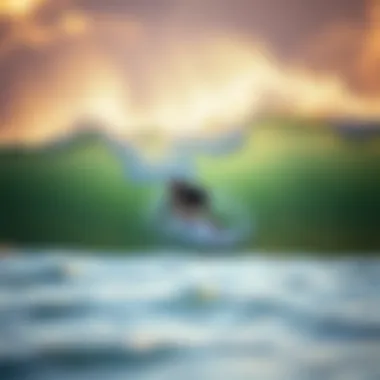
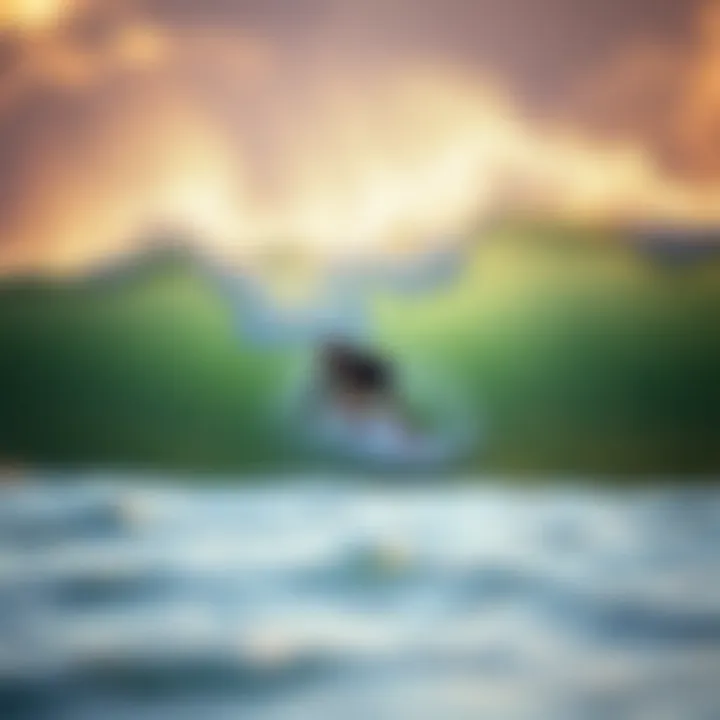
Intro
Surfing in Maui resonates with many as a dream experience filled with sun-soaked beaches and vibrant waves. As a newcomer to surfing, stepping into the ocean can feel both exhilarating and nerve-wracking. With a blend of awe-inspiring landscapes and a community that pulses with passion for the sport, Maui stands as an ideal destination to catch your first wave.
In Maui, the surfing scene isn't just a hobby; it's woven into the very fabric of island life. From the moment you hear the crash of the waves and see surfers gracefully gliding on water, you feel the call to join in. Yet, for beginners, the thought of hopping on a surfboard can seem more like a daunting task than a fun outing. Key considerations abound, such as favorable spots to surf, the right gear to obtain, and, perhaps most importantly, understanding safety protocols.
This article aims to guide you through this exciting journey. We’ll explore the fundamental surfing techniques, including tips and tricks to aid in your learning process. You’ll also discover essential gear tailored for novices and local resources that can enrich your experience. Perhaps above all, this guide is designed to bolster your confidence as you venture into the exciting world of surfing in Maui.
Let’s dive right into the nitty-gritty of surfing techniques that can help you make the most of your time on the waves.
Understanding Surfing Culture in Maui
To truly embrace surfing in Maui, it is essential to grasp the unique culture that surrounds this sport. Surfing is more than just a recreational activity; it embodies a lifestyle rooted in history, community, and respect for the ocean. This section explores the historical context, the pivotal Aloha spirit, and the local etiquette that newcomers must understand to seamlessly integrate into the surfing scene here.
Historical Context of Surfing in Hawaii
Surfing has deep roots in Hawaiian culture, dating back to the ancient Polynesians. It wasn't simply a sport; it served as a form of social structure where younger men would compete for status and admiration. This old practice, known as he'e nalu, illustrates how surfing was intricately linked to the Hawaiian identity.
As you stroll along the shores of Maui, think of it not just as water and waves, but as the very ground upon which a rich tapestry of history awaits exploration. During the 18th century, surfing gained prominence and became a significant part of the Hawaiian monarchy. Kings and chiefs showcased their prowess in the surf, which further cemented its importance in Hawaiian culture. The revival of the sport and its global spread in the 20th century made Hawaii the epicenter of surfing.
Understanding this history allows beginners to appreciate the significance of riding a wave in Maui, going beyond plain enjoyment to embodying a tradition that has survived centuries.
The Importance of Aloha Spirit
The essence of surfing in Maui is steeped in what the locals call the Aloha spirit. This is more than a simple greeting; it signifies love, compassion, and a sense of unity. Embracing the Aloha spirit is crucial for anyone wanting to surf in Maui. It means respecting the ocean, fellow surfers, and the island's culture.
Local surfers often speak of a deep connection with the water. When you paddle out into the sea, you join a community that values harmony and tranquility over competitiveness. The Aloha spirit fosters an atmosphere where everyone from novices to experienced surfers can share waves and experiences. This philosophy encourages beginners to ask questions, learn from others, and embrace the camaraderie that comes with surfing in such a beautiful locale.
Local Etiquette and Respect
With every wave comes an unspoken set of etiquette rules that all surfers, especially novices, should follow. Understanding local customs can be the difference between a great surfing experience and a negative one. Here are some key points to keep in mind:
- Respect the Locals: Local surfers show an inherent bond with certain spots. Never drop in on a wave that someone else is already riding. It’s considered disrespectful and could lead to conflict.
- Follow the Line-up: Know the order of surfers waiting for their turn. Give priority to those who have been waiting longer.
- Communicate: Use hand signals or verbal cues. Keeping everyone aware of your intentions helps avoid accidents and promotes a safer surfing environment.
- Don’t Take It All Too Seriously: Remember, surfing is about enjoyment, so keep the mood light.
Understanding these nuances builds respect and helps foster goodwill among surfers.
Best Beaches for Beginner Surfers
Selecting the right beach may very well be the most critical step for novice surfers. Not every beach is suited for newcomers, as factors like wave size, accessibility, and safety play a crucial role in their learning experience. Some beaches offer gentle waves and clear areas, which are quite conducive for beginners to practice their skills without the usual intimidation of more advanced surf spots. In Maui, not only is the scenery stunning, but there are specific beaches that cater to the needs of those just dipping their toes into surfing.
Among the various options, three standout locations are particularly well-suited for new surfers: Kamaole Beach Park, Ho‘okipa Beach, and Cove Park. These locales not only provide safe and manageable surfing conditions but also underscore the vibrant surfing culture of Maui.
Kamaole Beach Park
Kamaole Beach Park is often the place to be for beginners. This beach features three distinct sections, which offer ample opportunities for catching some gentle waves. The water here is usually warm and inviting, presenting a friendly atmosphere for those still finding their footing.
Key features of Kamaole Beach Park include:
- Gentle Waves: The waves here are generally mellow, making it a favorable choice for beginners trying to learn how to balance and ride.
- Facilities: The park is equipped with restrooms, showers, and picnic areas, making it a convenient spot for a full day at the beach.
- Educational Environment: Many surf schools operate out of Kamaole Beach, so newcomers can easily join lessons or seek guidance while feeling the welcoming effects of the nearby community.
This beach gives newcomers a real taste of what Maui has to offer in terms of surf culture without overwhelming them.
Ho‘okipa Beach
Ho‘okipa Beach is famed among surfers, but it can also accommodate beginners—provided that they choose their timing wisely. Known for its consistent waves and picturesque views, this beach attracts a mix of surfers, from newbies to the more experienced.
What makes Ho‘okipa special?
- Variety of Wave Conditions: While the waves can be more challenging at times, early mornings typically offer more manageable surf, allowing beginners to practice without the crowd.
- Spectacular Scenery: The natural beauty of the area, with lush surroundings and pristine waters, creates a serene backdrop that adds to the overall experience of learning to surf.
- Wildlife Observations: It’s not unusual to spot sea turtles lounging on the rocks, bringing an added excitement to your surf session.
While it may require some foresight to find the best conditions, the allure of Ho‘okipa Beach keeps many coming back time and again.
Cove Park
Cove Park offers an intimate setting that makes it an excellent choice for those just starting their surfing journey. The atmosphere here feels community-oriented, making it less intimidating for first-timers.
Highlights of Cove Park include:
- Protected Waters: The cove creates a natural barrier against larger waves, allowing for calmer waters that are ideal for newcomers perfecting their paddling and surfing stance.
- Ample Space: With plenty of room to spread out, surfers can practice without the fear of colliding with others, promoting a safe learning environment.
- Strong Surfing Community: Like Kamaole Beach, Cove Park is a hub for surf instructors and enthusiasts alike, allowing beginners to tap into a wealth of knowledge and support.
Overall, each beach presents unique advantages, making it easier for novice surfers to gain confidence in their abilities. Whether you're aiming for gentle waves or a sense of community, these spots provide valuable opportunities to learn and enjoy the sport.
Surfing isn’t merely a sport in Maui; it’s a way of life, and the beaches represent that ethos well.
Essential Gear for Beginner Surfers
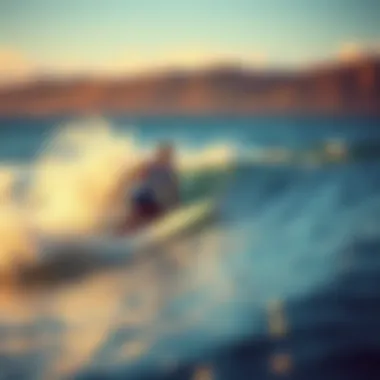
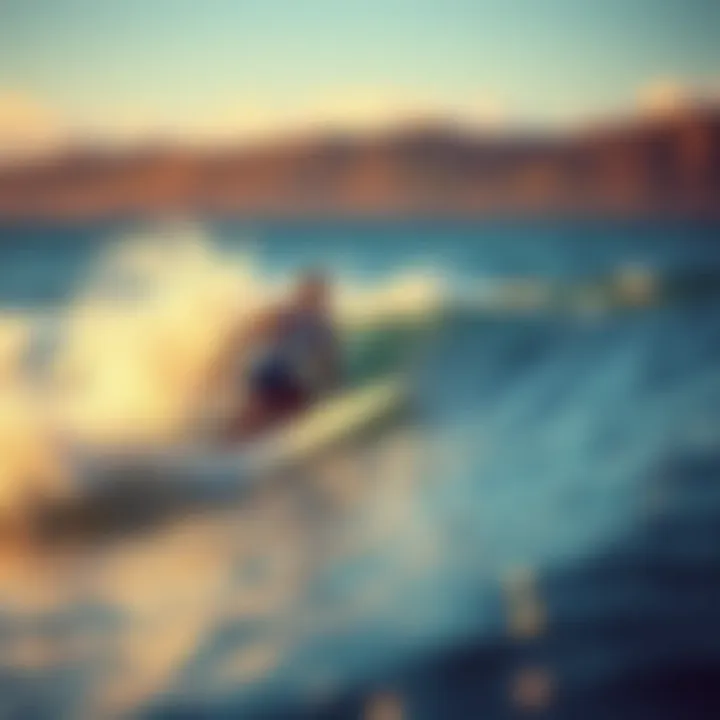
When diving headfirst into the world of surfing, having the right gear is as crucial as knowing how to paddle. Selecting appropriate equipment not only enhances your experience but also plays a pat on safety and comfort while in the water. For beginners, understanding the essential gear can make the journey smoother and more enjoyable.
Choosing the Right Surfboard
Choosing the right surfboard can feel like searching for a needle in a haystack, especially with so many options out there. It’s important to start with the right size and type to match your ability. Generally, beginner surfers are recommended to use longer boards, like a soft-top longboard.
These boards provide greater stability, which can drastically reduce the chances of wiping out. Soft-tops are forgiving when it comes to falls too, as they cushion, preventing nasty injuries in case you lose balance. Ranging from 8 to 9 feet long, these boards allow more surface area, which in turn makes paddling out easier.
Beyond size, keep in mind the board’s shape. For instance, boards with a more rounded nose help in catching waves more effectively. But this is just scratching the surface. As you advance, you might want to experiment with different shapes, such as fish or egg boards, which offer diverse experiences. Don’t hesitate to chat with local surf shops—they're often treasure troves of information.
Understanding Wetsuits and Their Uses
Wetsuits might seem like an extravagant accessory to some, but in Hawaii, they serve a practical purpose, especially for beginner surfers not yet accustomed to the colder waters deeper in the ocean. Wetsuits are designed to insulate heat, keeping you warm even when you're in the water for extended periods.
A major consideration when selecting a wetsuit is thickness. For warmer conditions like Maui, a 2mm shorty or spring suit can be a fine choice—allowing for flexibility without overheating. Ensure it fits snugly because a loose wetsuit won't trap heat effectively; you'll end up feeling like a popsicle on a chilly day. Don't forget to consider the season and specific spot you plan to surf; some areas might be chillier than others even in summer.
Safety Gear and Accessories
Safety should always be top of mind when surfing. As a beginner, gaining confidence in the water's unpredictable nature is key. Accessories like surf leashes, which connect you to your board, are essential. This prevents your board from floating off while you swim back, making it easier to stay within your comfort zone.
However, don’t just stop at leashes. Donning a rash guard can help prevent chafing caused by the board or the sun's harsh rays. For those new to surfing, a helmet might sound extreme, but it's a sensible option if you're concerned about wipeouts, particularly in more crowded surf conditions.
Epilogue
Investing in the right gear, from surfboards to wetsuits and safety equipment, can elevate your surfing experience. As you gear up, remember that every piece has a role in fostering your growth as a surfer, setting you up for success, and keeping you safe. Don’t hesitate to seek advice from seasoned surfers or shop professionals; their experience can save you from making costly errors.
If you’re looking for more information on surfing gear or need some guidance, check resources like Surfboard Magazine or REI's informative articles on surfing.
"The ocean is a vast teacher, and every wave that rolls in is a lesson for us to learn. Equip yourself, embrace the waves, and enjoy the ride!"
Basic Surfing Techniques for Newcomers
When embarking on the journey of surfing in Maui, mastering basic techniques is essential for any newcomer. These skills not only facilitate smoother riding but also enhance overall enjoyment and safety in the water. Being well-versed in fundamental techniques contributes significantly to building foundational strength and confidence, enabling budding surfers to embrace their new passion without intimidation.
Paddling Techniques
Paddling serves as the backbone of surfing, akin to the engine of a car. It's how surfers maneuver out past the breaking waves and into deeper waters where they can catch their first rides. Learning the right paddling technique is crucial.
An effective paddle begins with a strong body position. Swimmers should lie flat, keeping their body aligned and low. To paddle, start with alternating arms, reaching forward and pulling back through the water, all while maintaining a relaxed but firm grip on the board. Here are some tips:
- Keep your head down to minimize drag.
- Utilize your core muscles while paddling to preserve energy.
- Maintain a rhythmical stroke; it's a marathon, not a sprint.
Positioning on the Board
Proper positioning on the surfboard is like having the right stance in any sport. A balanced body posture ensures you'll catch waves effectively and maintain your composure once you do. Sitting too far forward or backward can impede lifting off the surface when a wave approaches.
To sit correctly, you should:
- Position your body so that your chest is just behind the center of the board.
- Keep your feet planted firmly on the board while maintaining a slightly bent knee.
- Trust your instinct and adjust as needed; every board has a sweet spot, and it might take some time to find yours.
Catching Waves
Catching waves is the moment when the magic happens; it's where the thrill of surfing resides. This phase requires both timing and precision. First, learn to recognize the signs of a good wave, like its shape and how it breaks.
Once you're confident, here’s how to catch a wave:
- Paddle hard when you see the wave approaching.
- Synchronize your paddling speed with the wave’s momentum.
- As you feel the board lift, give it one or two final powerful strokes to ensure you're riding the wave.
Stand Up and Ride
Standing up on the board is the pinnacle of surfing for many beginners, and doing so with grace is essential to transition from a good ride to a great one. This stage often requires practice and perseverance, but it’s ultimately fulfilling.
To stand, follow these steps:
- Push up into a plank position; your hands should be pressed against the rails.
- In one swift motion, bring one foot forward, in between your hands, planting it flat on the board.
- Follow quickly with the other foot, positioning it parallel to your first one. Keep your knees bent for stability, and find your center of gravity.
With these techniques in your toolbox, amateur surfers can look forward to truly enjoying their surfing sessions while inching closer to becoming competent riders. Remember, the ocean is as much about practice as it is about patience. Embrace each slip and slide as a lesson in your journey through the waves.
Understanding Ocean Conditions
Understanding ocean conditions is crucial for beginners seeking to embrace the waves in Maui. The ocean isn't just a vast body of water; it's a living entity that constantly shifts and changes, impacting how surfers should approach their sessions. Misreading these conditions can lead to less-than-pleasant experiences out on the water.
Reading Surf Reports
Surf reports are a lifeline for surfers, especially those just starting out. These reports provide valuable information about wave height, swell direction, and wind conditions for various beaches. Knowing how to read them can mean the difference between a successful day on a board and a day spent struggling against the elements.
- Wave Height: Generally, reports use a scale to indicate wave height. For beginners, waves of 1 to 3 feet are preferable. Anything above that can be challenging for newcomers.
- Swell Direction: Swell direction affects how waves break, and understanding this can help surfers position themselves better. Generally, a swell coming straight on is ideal for practicing.
- Wind Conditions: Offshore winds tend to clean up the waves, making them smoother, while onshore winds can create choppy, messy conditions. As a rule of thumb, a forecast with light offshore winds is what beginners should seek out.
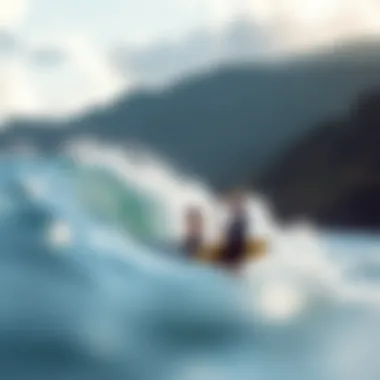
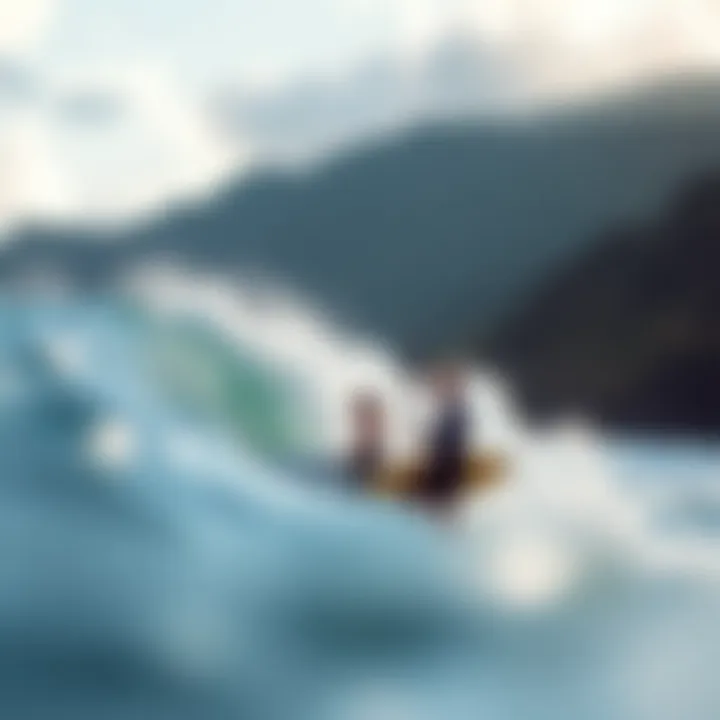
Identifying Swell and Wind Patterns
Being able to identify swell and wind patterns is a skill that can take time to develop, but it's incredibly rewarding once mastered. Swells can originate from storms far out at sea, traveling great distances before reaching shore.
- Look for Swell Size: Larger swells typically produce more powerful waves. Beginners should look for sessions when swells are small and manageable. The ideal condition is often indicated by clear, clean waves that break softly.
- Wind Influence: The wind plays a significant role in wave formation. If you're on the beach and see waves breaking cleanly with little interference, it's likely a good time to surf. Conversely, if you're seeing a lot of white water and choppiness, it might be best to wait until conditions improve.
"Understanding the rhythm of the ocean is the key to becoming a successful surfer. It’s not just about riding the wave; it's about flowing with nature."
Tides and Their Impact on Surfing
Tides must not be overlooked when planning a surf session in Maui. They fundamentally change how waves break at any given beach. Tides come in cycles of low and high, and each affects the surf conditions in various ways.
- Incoming Tides: Often, incoming tides can produce the best waves as they fill in sandbars and create more favorable breaks.
- Low Tides: Low tide can expose reefs or sandbars, which may create challenging long rides but also carries risk. It’s critical to remain mindful of the terrain and potential hazards, especially for beginners.
- Timing Your Sessions: Many local surfers will have their favorite spots tied to tides, indicating the best times to paddle out for optimal conditions. Keeping a simple tide chart can go a long way in making the most of your surfing experience.
By paying attention to these elements, beginner surfers will not only improve their skills more quickly but will also enhance their overall enjoyment of the sport. The ocean is many things, a playground, a teacher, and at times, a challenge. Understanding its conditions will provide a smoother ride in your surfing journey.
Safety Considerations for Beginner Surfers
When it comes to surfing, especially for those just dipping their toes in, understanding safety is paramount. Maui's beautiful waves can be inviting, but they also hold potential dangers that every newbie should be aware of. Just like a hawk eyes its surroundings before swooping in, beginners must grasp the safety consideration before hitting the water.
Potential Hazards in the Water
Surfing can be an exhilarating experience, but it’s not without its risks. Ocean conditions are ever-changing, and new surfers may not immediately recognize potential hazards. Here are a few things to bear in mind:
- Rip Currents: These powerful channels of water can pull even the strongest swimmers away from shore. They often appear as a stretch of water that’s churning differently than the rest of the ocean.
- Reef and Rocks: Many surf spots in Maui have coral reefs or rocky bottoms. If you fall off your board, these can present serious dangers. Avoid shallow areas where these hazards are more likely to be exposed.
- Wildlife Encounters: While it’s exciting to think about spotting a turtle or a dolphin, be mindful of what’s lurking beneath. Sharks do inhabit these waters, so staying aware is vital.
- Changing Weather Conditions: Sudden shifts in weather can lead to poor visibility, strong winds, and even lightning. Always keep an eye on the skies before heading out.
It's wise to check conditions before getting in the water. Websites like surfline.com and magicseaweed.com provide updated surf reports that can help you gauge safety.
The Importance of Surfing Lessons
For anyone looking to ride the waves, taking surf lessons isn’t just a good idea - it’s essential. An experienced instructor can make all the difference for beginners by providing tailored guidance. Here’s why enrolling in lessons is beneficial:
- Skill Development: Learning from a professional allows you to grasp the fundamentals fast. You'll develop the basics of paddling, positioning, and timing.
- Safety Awareness: A qualified instructor will teach you about local conditions and potential hazards, ensuring you're more prepared.
- Confidence Building: Starting with a professional can alleviate many anxieties that come with beginning a new sport. You’ll feel more comfortable tackling the waves with an expert by your side.
Knowing When to Seek Help
Understanding your limits is just as important as learning techniques. New surfers should feel empowered to ask for help and know when to reach out. Here are some scenarios to consider:
- Feeling Out of Control: If you’re struggling to maintain control of your board or if the waves feel too intimidating, it’s completely fine to signal for assistance.
- Injury Concerns: If you feel any pain or discomfort, particularly in the water, don’t hesitate to raise your hand. Fellow surfers or lifeguards are there to help.
- Persistent Translation Troubles: If language barriers are at play, don’t shy from asking for a translator or assistance - many surf schools are accustomed to teaching beginners from various backgrounds.
Navigating the waters in Maui isn’t just about catching waves; it’s about ensuring your safety and respecting the ocean. Each trip to the surf brings with it a unique set of challenges, but by staying vigilant and seeking help when needed, you can cultivate not just skill but a deeper appreciation for this thrilling sport.
Maui Surf Schools and Resources
Navigating the world of surfing can be a daunting task for newcomers, especially in a place as vibrant and diverse as Maui. Surf schools play a crucial role in this adventure. They serve as the cornerstone for beginners, providing not only essential instruction, but also an introduction to the local culture and community.
Maui's surf schools offer tailored courses for all skill levels, ensuring that every surfer, regardless of experience, can get started on the right foot. These schools provide a structured learning environment, proper safety protocols, and qualified instructors who know the ins and outs of the local waves. This immersion aids in building confidence, improving technique, and fostering a connection with the ocean that many surfers treasure.
Finding the Right Surf School
When it comes to choosing a surf school, there’s no one-size-fits-all solution. Assessing your own personal goals is an important first step. Here are some factors to consider:
- Reputation: Look for schools with positive reviews and a solid track record. Word-of-mouth recommendations from locals can often lead you to hidden gems.
- Instructor Qualifications: Ensure instructors are certified and have substantial experience teaching surfing. Many schools feature instructors with professional backgrounds and lifeguard certifications.
- Class Size: Smaller groups often mean more personalized instruction, allowing for tailored feedback and quicker progression.
- Location: Consider the schools located on friendly beginner beaches, like Kamaole Beach Park or Cove Park.
Local Surfing Communities and Forums
Getting involved in local surfing communities can greatly enhance your surfing experience. Communities often provide support, motivation, and even opportunities to connect with fellow surfers. Here are a few ways to engage:
- Meetup Groups: Platforms like Facebook and Meetup often have surfing groups where you can find upcoming events or gatherings.
- Reddit Communities: Subreddits like r/surfing can be fantastic places to seek advice or share experiences.
- Local Events: Participating in local competitions or charity surf events can help you connect with like-minded individuals and gain insights on the local surf culture.
Utilizing Online Resources and Tutorials
In today’s digital age, a wealth of knowledge is at our fingertips. Numerous online resources can aid in enhancing your surfing skills and ocean awareness:
- YouTube Videos: Channels like “Surf Simply” or “How to Surf” offer free tutorials on various aspects of surfing.
- Online Courses: Websites like Udemy and Coursera provide structured surfing courses, covering everything from basic techniques to advanced maneuvers.
- Surfing Apps: Applications designed to track surf conditions or provide information on tides and swells, like Surfline and Magicseaweed, are essential.
"Learning to surf is a journey, and the right resources can make all the difference in turning that journey into a fulfilling adventure."
In summary, engaging with surf schools, participating in local communities, and utilizing online tutorials equips beginners with the necessary tools and insights for a successful surfing experience in Maui. Whether it’s through hands-on lessons or virtual learning, these resources are invaluable stepping stones in the exhilarating world of surfing.
The Environmental Context of Surfing
Understanding surfing in Maui goes hand in hand with recognizing the environmental aspects that come into play. The ocean is not just a playground; it’s a delicate ecosystem that warrants attention and care. This section emphasizes the significance of surfing within the broader environmental framework, highlighting the interconnectedness of the sport and the well-being of marine life and coastal areas.
Protecting Maui's Marine Life
Maui's waters are home to a rich array of marine life, from vibrant coral reefs to majestic sea turtles. These habitats face threats from pollution, overfishing, and climate change. As beginner surfers, it’s crucial to be aware of how our actions can impact this unique ecosystem. Here are some key considerations:
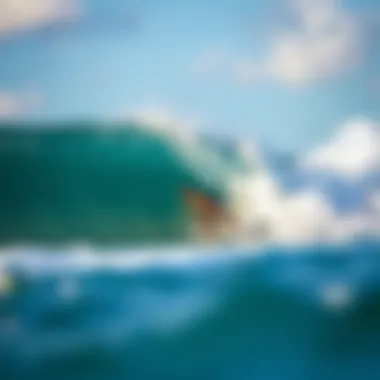
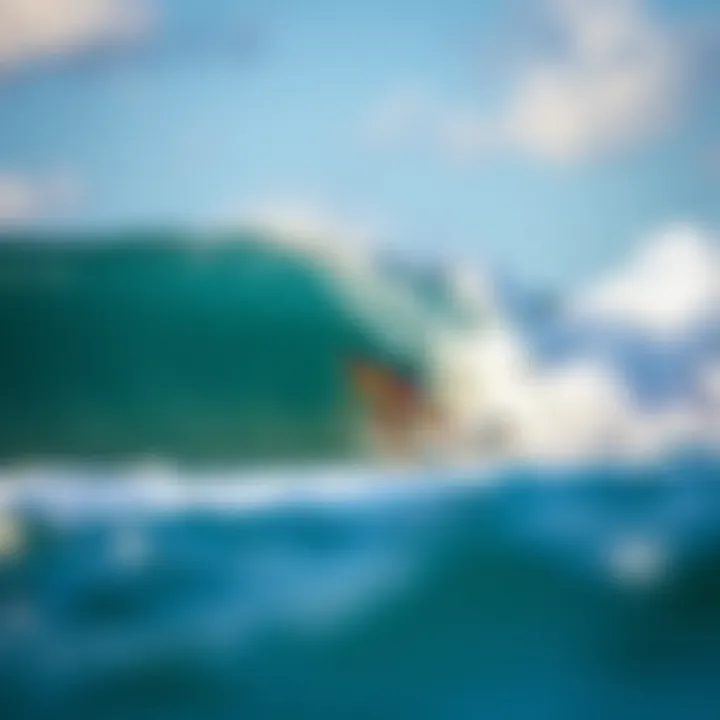
- Trash Disposal: Always carry out what you bring in. A simple piece of trash can harm wildlife if left behind.
- Respecting Wildlife: When surfing, you might encounter sea turtles or fish. Keep a respectful distance to avoid stressing them.
- Coral Reef Awareness: Avoid stepping on coral when getting in or out of the water. Coral ecosystems can take decades to recover from damage.
"By safeguarding our natural surroundings, we not only preserve the beauty of Maui, but also ensure future generations can enjoy the sport we love."
Sustainable Surfing Practices
Adopting sustainable habits in surfing is more than just a trendy slogan; it's a necessary shift for the times we live in. Beginner surfers can make a difference through conscious choices and practices:
- Eco-friendly Gear: From surfboards made of recycled materials to natural wax options, look for products that have minimal environmental impact.
- Carbon Offset Programs: If traveling to Maui, participate in initiatives that counterbalance carbon footprints, such as tree planting.
- Educate and Advocate: Share knowledge about ocean preservation with fellow surfers. Awareness breeds respect and care.
In a broader view, becoming part of sustainable surf culture helps cultivate a community that treasures our oceans, making it a priority to protect them. By incorporating these practices into your surfing journey, you contribute to a more harmonious relationship between the sport and the ocean.
Embracing the environmental context of surfing not only enhances our experience but also nurtures the ecosystems that nurture us. It transforms surfing into a practice that respects nature while providing joy, adventure, and a sense of belonging within the surfing community.
Preparing for Your First Surf Session
Getting ready for your inaugural surf session is an exciting yet crucial step in your surfing journey. This phase sets the tone for your experience on the waves and can significantly influence your first impressions of the sport. Understanding what to anticipate and preparing both physically and mentally serves as a foundation for not just that day, but your entire surfing adventure.
The first element to consider is the logistics of the day. Knowing the weather conditions, tide schedules, and wave patterns can prepare you to make the most of your surf sesh. Such details are vital. Few things are more disheartening than arriving at a beach only to find conditions unsuitable for beginners.
It’s equally important to pack appropriately. Bringing the right gear isn’t just about having a good time—it's about making sure you're comfortable and safe. This includes your surfboard, wetsuit, sunscreen, and water. Hydration cannot be overlooked. Get into the habit of drinking plenty of water before you hit the waves, as the sun and exertion can quickly sap your energy.
- Key Aspects to Prepare Your First Surf Session:
- Check Weather and Conditions: Use resources like surf reports from Surfline or local surf shops.
- Pack Your Gear: Surfboard, wet suit, sunscreen, water.
- Arrive Early: Familiarize yourself with the surf spot and its atmosphere.
- Understand the Surf Culture: Being aware of etiquette lets you align with local norms.
Preparing for this first leap onto the board helps form both a physical and mental readiness. Knowing you’ve done your homework boosts your confidence.
What to Expect on Your First Day
Stepping onto the sandy shore for your first surfing session may toss a healthy mix of excitement and nervousness your way. It's normal to feel butterflies in your stomach, but get ready to dive into a world that promises unforgettable memories.
On arrival, you'll likely see a diversity of surfers out in the water, showcasing varying levels of skill. Pay attention and absorb the atmosphere. You might notice some fellow new surfers fumbling about but also seasoned surfers gliding effortlessly across the water’s surface. This contrast can be encouraging—you, too, will learn!
Your instructor or guide will likely cover safety measures before you hit the waves. This is essential. You’ll hear discussions about identifiers like rip currents or protective areas where swimming is not advisable. Understanding these aspects keeps you safe.
After getting suited up, you can expect to undergo a brief session on land where the basics are covered. Techniques for paddling, positioning, and standing up on the board will be shared. These lessons are foundational; they form the core of your first scoot into the water and will ensure that you leave some balance behind.
Expect splashes and falls! Falling is part of the process. As the saying goes, "you gotta fall before you fly." These tumbles in the water act as both lessons and motivation. It can be daunting, but don’t let the falls cloud the fun.
Experience shows: Every surfer, no matter how experienced, has faced their share of wipeouts. Just keep getting back on the board.
Mental Preparation and Mindset
Surfing isn’t only about the physical act of riding waves but also about mental preparation. Cultivating the right mindset can dramatically affect your first experiences.
Begin with setting realistic expectations. Yes, you may not stand perfectly on your first attempt, and that’s perfectly acceptable. Adopting a learning mentality, rather than focusing on perfection, opens you up to gaining insights from each wipeout. Think of every tumble as an opportunity to improve.
Visualize yourself riding the wave before plunging into the water. This technique isn't just for seasoned pros; imagining yourself successfully catching a wave can calm nerves and swap anxiety for anticipation.
Keep in mind that surfing is equally a social experience. Engaging with fellow beginners or locals allows you to bond over shared challenges, stories, and victories. Laughing with others about your stumbles can lighten the atmosphere, making it easier to embrace the journey.
Practicing patience is key as well. Each session may not yield the immediate successes you're longing for. Take it as it comes, appreciate each ride, and build from there. Surfing is as much about the journey as it is the destination.
- Key Mindset Tips for Your First Surfing Experience:
- Set Realistic Goals: Focus on improvement rather than perfection.
- Visualize Success: Picture yourself enjoying the ride.
- Cultivate Patience: Growth takes time; celebrate small victories.
- Engage with Others: Shared experiences often ease anxiety.
By approaching your surf day as an adventure with its ups and downs, you'll set yourself on the path to not just learning surfing but truly experiencing it.
Post-Surf Care and Recovery
After an exhilarating day catching waves, understanding post-surf care and recovery is crucial for any beginner. It’s the unsung hero of your surfing journey. Without proper care, you might find yourself more sore than refreshed after your sessions, which can negatively impact your enjoyment of this beautiful sport.
By investing a bit of time in recovery, you not only enhance your performance for future sessions but also decrease the risk of injury. Surfing can be demanding on the body; your muscles and joints will appreciate attention once you exit the water. A little self-care goes a long way, ensuring you're ready to hit the waves again as soon as the next possible moment.
Proper Hydration Techniques
Staying hydrated is just as important as mastering your paddling technique. The ocean's salty water can dehydrate you quickly, especially on hot sunny days typical in Maui. Here’s how to quench your thirst properly:
- Drink Water Before and After: Aim to drink water both before your surf session and immediately after. It helps replenish lost fluids and can aid muscle recovery.
- Electrolyte Drinks: Sometimes, plain water doesn't cut it. After a demanding surf, consider drinks that help maintain electrolyte balance, like coconut water or sports drinks.
- Listen to Your Body: Feeling thirsty might be a sign that you’re already dehydrating. Sipping small amounts frequently can keep your hydration levels topped off without overwhelming your stomach.
"Hydration is not just about quenching thirst; it's about preparing your body for performance and recovery."
Taking these steps not only keeps you refreshed but also elevates your overall surfing experience.
Stretching and Recovery Exercises
As the sun sets and you step away from the surf, dedicating time to stretching and recovery exercises is essential. Surfing utilizes various muscle groups, from your core to your legs and arms. If you want to keep surfing comfortably, incorporate these practices into your regimen:
- Post-Surf Stretching: Engaging in gentle stretching post-surf can ease muscle tension and enhance flexibility. Focus on your:A simple stretch routine can be beneficial. For example, try holding a downward dog position for a minute to stretch out your back and hamstrings.
- Foam Rolling: If you have access to a foam roller, using it to massage your muscles can significantly reduce soreness. Roll out tight spots, especially on your quads and back, to improve blood flow and decrease tension.
- Yoga for Recovery: Maybe give yoga a whirl. It’s not just a workout; it's a mindset. Engaging in yoga sessions regularly can boost your flexibility while calming your mind, which may be just what you need before your next surf outing.
- Hamstrings
- Shoulders
- Back
- Calves















